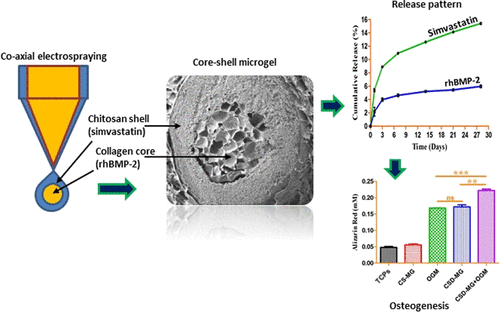当前位置:
X-MOL 学术
›
ACS Appl. Polym. Mater.
›
论文详情
Our official English website, www.x-mol.net, welcomes your
feedback! (Note: you will need to create a separate account there.)
Single-Step Fabrication of Core–Shell Microgels for the Controlled Release of rhBMP-2 and Simvastatin to Induce Osteogenesis
ACS Applied Polymer Materials ( IF 4.4 ) Pub Date : 2020-10-27 , DOI: 10.1021/acsapm.0c00815 Lalit Kumar Meena 1 , Hilal Ahmad Rather 1 , Rajesh Vasita 1
ACS Applied Polymer Materials ( IF 4.4 ) Pub Date : 2020-10-27 , DOI: 10.1021/acsapm.0c00815 Lalit Kumar Meena 1 , Hilal Ahmad Rather 1 , Rajesh Vasita 1
Affiliation

|
Dual delivery of bioactive molecules (drugs and growth factors) has been attempted to enhance multiple processes during tissue regeneration. For bone tissue engineering, many attempts have been made to enhance osteogenesis coupled angiogenesis, which plays a major role during the bone regeneration process. In this study, core–shell microgels were fabricated for controlled release of recombinant human bone morphogenetic protein 2 (rhBMP-2) and simvastatin from the core and shell, respectively. The microgels were formed with a discrete core and shell structure. The Fourier transform infrared analysis demonstrated the composition of microgel, whereas swelling behavior demonstrated its rapid swelling property. Thermal properties demonstrated the ionic gelation in microgels, which minimizes the thermal degradation of polymers. The degradation study demonstrates that the core–shell structure of microgels was intact until 49 days under physiological conditions. The release profile demonstrates the sequential and controlled release of rhBMP-2 from the core and simvastatin from the shell of the microgels, respectively. The bioactivity of rhBMP-2 and simvastatin released from microgels was preserved as indicated by the alkaline phosphatase (ALP) activity assay. The cell proliferation of mouse preosteoblast (MC3T3-E1) cells and the live–dead staining assay demonstrated cytocompatibility of the microgels. Scanning electron microscopy images demonstrate that the microgels support adhesion of cells on the surface and promote extracellular matrix (ECM) production. The osteogenic differentiation of MC3T3-E1 cells demonstrated the synergistic effect of drugs and growth factors up to 21 days. The controlled and sustained release of simvastatin and rhBMP-2 induced higher mRNA and protein expressions of RUNX2, osteocalcin, and VEGF. The overall results demonstrate the effect of controlled release of rhBMP-2 and simvastatin from core–shell microgels to promote osteogenesis and angiogenesis.
中文翻译:

一步一步制备核壳微凝胶以控制rhBMP-2和辛伐他汀的释放以诱导成骨
已尝试双重递送生物活性分子(药物和生长因子)以增强组织再生期间的多个过程。对于骨组织工程,已经进行了许多尝试来增强成骨作用和血管生成,这在骨再生过程中起着重要作用。在这项研究中,制备了核壳微凝胶以分别从核和壳中控制释放重组人骨形态发生蛋白2(rhBMP-2)和辛伐他汀。形成具有离散的核和壳结构的微凝胶。傅里叶变换红外分析证明了微凝胶的组成,而溶胀行为证明了其快速溶胀性能。热性质证明了微凝胶中的离子凝胶化,这使聚合物的热降解最小化。降解研究表明,在生理条件下,微凝胶的核-壳结构一直保持到49天。释放曲线表明,rhBMP-2分别从微凝胶的核心和辛伐他汀依次释放和受控释放。从微凝胶中释放的rhBMP-2和辛伐他汀的生物活性得以保留,如碱性磷酸酶(ALP)活性测定所示。小鼠前成骨细胞(MC3T3-E1)的细胞增殖和活死染色实验证明了微凝胶具有细胞相容性。扫描电子显微镜图像表明,微凝胶支持细胞在表面上的粘附并促进细胞外基质(ECM)的产生。MC3T3-E1细胞的成骨分化显示药物和生长因子的协同作用长达21天。辛伐他汀和rhBMP-2的控制和持续释放引起RUNX2,骨钙素和VEGF的更高mRNA和蛋白表达。总体结果表明,从核壳微凝胶中控制rhBMP-2和辛伐他汀的释放可以促进成骨和血管生成。
更新日期:2020-11-13
中文翻译:

一步一步制备核壳微凝胶以控制rhBMP-2和辛伐他汀的释放以诱导成骨
已尝试双重递送生物活性分子(药物和生长因子)以增强组织再生期间的多个过程。对于骨组织工程,已经进行了许多尝试来增强成骨作用和血管生成,这在骨再生过程中起着重要作用。在这项研究中,制备了核壳微凝胶以分别从核和壳中控制释放重组人骨形态发生蛋白2(rhBMP-2)和辛伐他汀。形成具有离散的核和壳结构的微凝胶。傅里叶变换红外分析证明了微凝胶的组成,而溶胀行为证明了其快速溶胀性能。热性质证明了微凝胶中的离子凝胶化,这使聚合物的热降解最小化。降解研究表明,在生理条件下,微凝胶的核-壳结构一直保持到49天。释放曲线表明,rhBMP-2分别从微凝胶的核心和辛伐他汀依次释放和受控释放。从微凝胶中释放的rhBMP-2和辛伐他汀的生物活性得以保留,如碱性磷酸酶(ALP)活性测定所示。小鼠前成骨细胞(MC3T3-E1)的细胞增殖和活死染色实验证明了微凝胶具有细胞相容性。扫描电子显微镜图像表明,微凝胶支持细胞在表面上的粘附并促进细胞外基质(ECM)的产生。MC3T3-E1细胞的成骨分化显示药物和生长因子的协同作用长达21天。辛伐他汀和rhBMP-2的控制和持续释放引起RUNX2,骨钙素和VEGF的更高mRNA和蛋白表达。总体结果表明,从核壳微凝胶中控制rhBMP-2和辛伐他汀的释放可以促进成骨和血管生成。











































 京公网安备 11010802027423号
京公网安备 11010802027423号